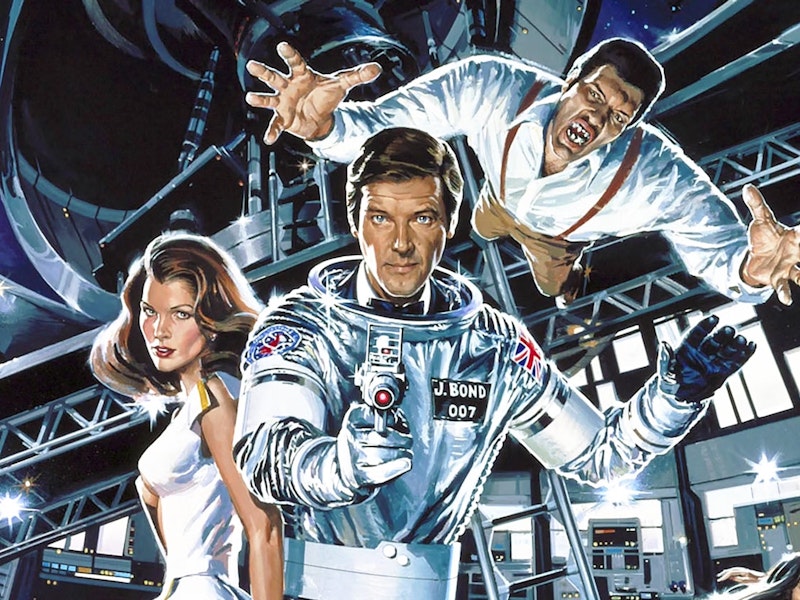The James Bond film franchise has been around long enough that Bond, like Spider-Man or Captain Kirk, is a character most people remember from childhood. There’s a quality of nostalgia to him and his stories: the name James Bond evokes half-remembered tales of uncomplicated goodies and baddies, and an ordered world shaped by imperial powers which nevertheless needs a bloody-handed spy to defend against threats lurking in the shadows.
As a child, I was disappointed by the first Bond movie I saw. The title and posters of 1979’s Moonraker promised something like Star Wars, and it’s not like that movie at all. Today I enjoy it more than most, I think, so perhaps nostalgia’s at work without my noticing it.
The opening sequence features the improbable theft of a space shuttle in midair. Bond’s assigned to track it down, and a sequence of unlikely clues leads him to a compound in California, then to Venice, then to Brazil. Along the way he encounters astronaut Holly Goodhead (Lois Chiles), who’s inevitably more than she appears, and fights unspeaking heavy Jaws (Richard Kiel), returning from the last film as the flunky of evil billionaire Hugo Drax (Michael Lonsdale). Drax has his own space station and a master plan, so the climax of the film is set in space as things blow up and lasers blast away and Drax’s forces have a pitched zero-gravity battle with US marines in space suits.
This is nothing like Ian Fleming’s book. By this point the films are made in a world that’s moved on technologically from the world in which the books were written, and since these stories have a fascination with gadgetry and high-tech imagery they must evolve to match. This one might’ve gone too far.
Moonraker’s in some ways the most science-fictional of Bond films; other movies heighten filmic reality in a vaguely science-fictional direction, with invisible cars and nanotech poisons, but this one has laser weapons. space shuttle flights and a massive space station all well beyond contemporary technology. (Worth noting that the American space station Skylab burned up in the atmosphere the same month this film opened.) As pulp science fiction it’s oddly structured, with no foreshadowing of the space-set climax until Bond takes off aboard a shuttle. But it’s a welcome return to the technothrillers of previous films, a fair attempt at creating a world as much heightened beyond 1979 as On Her Majesty’s Secret Service was beyond 1969.
The script’s by Christopher Wood, who’d written a novelization of the previous film, The Spy Who Loved Me, which also had nothing in common with the Fleming source novel except the title. Lewis Gilbert returns as director and Ken Adam does his usual fine job as production designer, bringing out the old-world richness of Venice and the contrasting super-scientific space station. Much of the film was shot in France for tax reasons, and cinematographer Jean Tournier does a fine job. Between Tournier, Adam, and Gilbert, this movie’s one of the better-looking Bond films. The compositions, and John Glen’s editing, aren’t notable, but the colors and effects work are solid—visual effects supervisor Derek Meddings got an Oscar nomination for his efforts.
The overall pace is good, and the action scenes are varied, set in a number of different venues. Bond has a lot of gadgets and trick vehicles, too many in the opinion of some. I feel the range of set-pieces justifies the number of gadgets, but then I also don’t have a problem with watching Bond navigate a chase through Venetian canals aboard a hybrid gondola/hovercraft (nicknamed the Bondola).
There are problems in surprising places. Jaws is a good heavy, but he’s less effective here than in The Spy Who Loved Me, with an incomprehensible romance sub-plot. And the villain’s evil scheme is a direct replay of the evil scheme from the last movie, with space in place of the ocean. It’s interesting to see that Bond’s moved from fighting an evil secret society of thieves and crooks to fighting evil billionaires, but, as many of us feel in the 21st century, one wishes evil billionaires had more imagination.
The acting’s bland. Neither Chiles nor Lonsdale make their characters live, though neither are helped by the dialogue. Chiles has to play through a particularly 1979 moment in her introduction, when Bond’s surprised to learn “Dr. Goodhead” is a woman. “On loan from NASA, the space administration,” she cheerfully tells him, in case the audience doesn’t know what NASA is 10 years after the moon landing. Roger Moore, meanwhile, doesn’t even try to give Bond a character arc, and recedes as the movie goes on so that for perhaps the first time Bond becomes the least interesting aspect of a James Bond movie. At least he pulls off the action scenes.
The special effects succeed. The plot of Bond’s investigation is incoherent, a little more than usual. But the Bond movies are often at their best when the plot’s ropey, letting the story become dreamlike. The action of the climax is strong until the end, when the audience is suddenly left staring at Holly Goodhead playing a video game.
The humor’s inconsistent, occasionally sinking to the level of that other British film institution, the Carry On movies. But that’s not a crippling flaw. Mostly Moonraker’s the good kind of bad, inventive and not dull, with attractive stuff happening on screen. It bumps up against the outer edges of what you can get away with in a Bond film before the film turns into a different genre of movie, but to me it doesn’t go beyond those boundaries. Then again, it was the first Bond film I saw, and set my expectations for the others. For better or worse.

